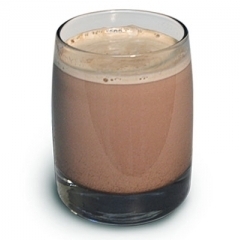Leaderboard
Popular Content
Showing content with the highest reputation on 11/20/2024 in all areas
-
Can't tell exactly how many nubbins there are on the base there, but if I guess 8, then we can set the segments on our initial geo to a multiple of that number, so here 16. I started with a disc, added a single loop cut where I wanted the nubs to stop, and then selected pairs of segments to extrude (no caps) or ctrl-drag an arbitrary amount to get the bumps... We can't do all them in one go if they are next to each other, so I did them 4 at a time. And then it's over to SDS to do the rest of the work for you... I quadded the centre to avoid a nasty SDS pinch there (close poly hole / patch mode). Without seeing the bottom view of the bottle, and without any similar ones lying about at home for refs, I don't really know how the bumps fade out towards the centre, but we can easily adjust that by moving the inner circle of extruded points, or we can add one more loop cut half way between edge and centre to better define that transition. You don't want to add more than 1 loop though, as then shapes will start to become too defined under SDS. The little grip bits in the cap are such relatively tiny details, nobody is going to notice if you do it in texturing, but TBH it is quicker still to just model them separately and slightly intersect them with the main model, and we certainly don't want the rest of the mesh at the sort of resolutions that the grip section would require if it were part of it ! So if you want to do that just start with a tall cube in a radial cloner, add enough Y segments to it so they SDS with the correct amount of roundness, and then set the radius in the cloner and adjust the amount and size until it looks right. It's hard to see from the pic, but it looks to me like the plastic wrap stops before the ridged bit, so we shouldn't need to worry about that ? But no matter if we do. To get the plastic wrap layer we can directly split the wrap polys from the base mesh, and then just manually adjust a few loops so it gets round the bumps OK and add parametric thickness with Thicken generator or manually via a tiny 'caps on' extrude. CBR2 points
-
1 point
-
Hello everyone I am happy to announce that of Decemeber 1.st adsense will be removed. This will make the forum browsing experience become much nicer Thank you!1 point
-
Righty - here's how I'd go about modelling that base... We have 12 way rotational symmetry, and within that 2 way planar symmetry, meaning we only have to design topology for a nice small manageable section. And we don't need to go to the centre with that, because that is on a dual axis curve so we don't want any poles there. We'll make a patch for that later. 1. I started by outlining the main nubbin with as few polys as I thought I could get away with (whilst still keeping them mainly even)... I am using HB retopo for this, but if you find yourself without that, then polygon snap will do just fine in a pinch, and you could even shrink wrap onto the CAD model to more rigidly stick to that surface as you work)... I am working with symmetry here, so have only modelled the right side... you can optionally use the symmetry Hub / mode, but for technical reasons, I didn't on this occasion ! 2. Next, let's patch that any old how, expecting to need to revise it later, and expand the upper border... mostly using poly pen here, and frequently utilising things like smooth edges and equal spacing to keep things neat... 3. We need to continue out to half way across the square block bits, so did that, trying to keep edges as even as possible. 4. But now my modelling spidey senses kick in to suggest we'll be needing some harder edges and corners on the inner edge of the square bits, and that we should continue the lower loop around the indent on, to keep its outer control loop flowing around it (rather than down towards the centre), which led to the following topology changes... So I've run an extra loop across the square bit, and slid some edges about to get tight control loops for those corners, but, crucially, have got 4 evenly spaced edges at both inner and outer borders, which is vital for perfect SDS circularity (top) and partial sphericity (inner). I actually went on a bit beyond this to tighten those corners further before the next stage, and added some consistency as to how I did the cornering and additional loops round bevels for better base mesh definition. 5. So, having got one segment of the 12 mostly right, we can radial clone that x 12 to get the complete outer ring for the base. That'll need to be in a connect (weld on) to join those together. Having done that, we can make that connect editable, and count our border edges, which in my case was 48, which we can divide by 4 to conclude that we need a 12 x 12 plane for that centre section, and we will need to make that editable, Fit Circle it, relax / iron the inner points, project it to the CAD model (shrink wrap deformer) so we match the curve exactly and then CO&D that to the connect we made earlier, which should match perfectly if plans have gone well thus far... This means we don't have any complex poles in the base on that subtle curved area at the centre, which is important, because even though the slope is quite gentle there, it curves in 2 directions at once, so triangles or pole counts more than 4 will produce SDS artefacts that will be variously noticeable and not fixed by adding more SDS levels. SDS L3 is perfectly sufficient for this unless we choose to use SDS edge weighting (not necessary here), which would necessitate an extra level of it. ...and that leaves us a very manageable 48 radial polys with which to work our way up the rest of the bottle... We conclude that section with an Optimize, and checking it with Mesh Checker to hopefully reveal all quads and no borders, isolated points, or other errors ! 🙂 Hope that helps CBR1 point
-
Vonc Material Cleaner : Code Vonc - Tools AR Scripts : GitHub - aturtur/cinema4d-scripts: My collection of Cinema 4D scripts1 point
-
Aha ! If we have the CAD, then things become a lot clearer / more accurate, and indeed I can now see that the bottom of this bottle is not very much like the coke-style one I guessed it might be originally ! 🙂 The principals I highlighted above though still hold true, in that we should still start at the bottom and work our way up. So this is the ref for our base... So, if we want to throw this at ZRM (usually a good idea, just to see, and sometimes we can be pleasantly surprised by how good the result is !) we should rotate the model first from its default position so that the Symmetry options in ZRM can usefully apply, thus increasing our chances of getting mesh consistency across the model... And as we can see, we can get a really pretty reasonable easy quick result, that would be sufficient for getting fairly close to the object with the camera if we do that... But perfection it is not, and if you are one of the few remaining artists for whom modelling nicely is a pleasure in and of itself AS WELL as getting us to a much more perfect result, then I would say it is worth the effort of doing it properly with SDS modelling. The downside of re-mesher is that its polygon efficiency is arbitrary / based on user-input number / percentage, it can't detect flow very well automatically (see those indents at the off-axis angles) and we that need quite high numbers of polys in the base mesh to accurately gain those shapes, which is quite inefficient and nearly always leads to it using way more polys than it should have to. However, even if we do intend to model this 'properly', we can gain a good understanding of the sort of polygon density that should be possible, and get ideas for the flow of certain (on-axis) features that might not have occurred to us initially, so it's all good XP... I have some spare time later today, so will pop back then with a new plan for that base, hopefully demonstrating the optimum topology there. CBR1 point
-
Is there a handy dandy retopo solution for a squiggly mess like this? Or is it best to just start again? I would be tempted to break out the Boole for the base section now - maybe if I made one and then put it in a radial cloner? bottle.fbx Some investigation has led me to discover they have incorporated zremesh into C4D when I wasnt looking, which I will investigate, but I would probably prefer to remake it just because we all know it's the right thing to do 🙂1 point
-
Actually I've managed to get old of the CAD file and can see the bottom of the bottle now - quad fans you might want to take a deep breath when you see this one:1 point
-
1 point
-
@DALII Here is how you can split any spline into parts between control points. This makes it easier to process since you will always work on single spline with two points. You can then resample that any way you find useful split_control_points.c4d1 point


